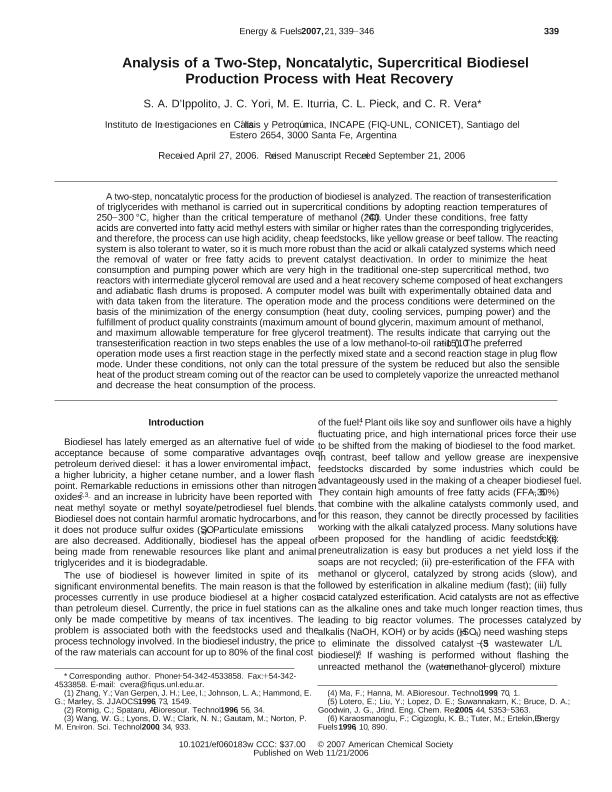Mostrar el registro sencillo del ítem
dc.contributor.author
D'ippolito, Silvana Andrea

dc.contributor.author
Yori, Juan Carlos

dc.contributor.author
Iturria, M. E.
dc.contributor.author
Pieck, Carlos Luis

dc.contributor.author
Vera, Carlos Roman

dc.date.available
2018-12-05T19:12:42Z
dc.date.issued
2007-01
dc.identifier.citation
D'ippolito, Silvana Andrea; Yori, Juan Carlos; Iturria, M. E.; Pieck, Carlos Luis; Vera, Carlos Roman; Analysis of a two-step, noncatalytic, supercritical biodiesel production process with heat recovery; American Chemical Society; Energy & Fuels (print); 21; 1; 1-2007; 339-346
dc.identifier.issn
0887-0624
dc.identifier.uri
http://hdl.handle.net/11336/65910
dc.description.abstract
A two-step, noncatalytic process for the production of biodiesel is analyzed. The reaction of transesterification of triglycerides with methanol is carried out in supercritical conditions by adopting reaction temperatures of 250-300 °C, higher than the critical temperature of methanol (240 °C). Under these conditions, free fatty acids are converted into fatty acid methyl esters with similar or higher rates than the corresponding triglycerides, and therefore, the process can use high acidity, cheap feedstocks, like yellow grease or beef tallow. The reacting system is also tolerant to water, so it is much more robust than the acid or alkali catalyzed systems which need the removal of water or free fatty acids to prevent catalyst deactivation. In order to minimize the heat consumption and pumping power which are very high in the traditional one-step supercritical method, two reactors with intermediate glycerol removal are used and a heat recovery scheme composed of heat exchangers and adiabatic flash drums is proposed. A computer model was built with experimentally obtained data and with data taken from the literature. The operation mode and the process conditions were determined on the basis of the minimization of the energy consumption (heat duty, cooling services, pumping power) and the fulfillment of product quality constraints (maximum amount of bound glycerin, maximum amount of methanol, and maximum allowable temperature for free glycerol treatment). The results indicate that carrying out the transesterification reaction in two steps enables the use of a low methanol-to-oil ratio (10-15). The preferred operation mode uses a first reaction stage in the perfectly mixed state and a second reaction stage in plug flow mode. Under these conditions, not only can the total pressure of the system be reduced but also the sensible heat of the product stream coming out of the reactor can be used to completely vaporize the unreacted methanol and decrease the heat consumption of the process. © 2007 American Chemical Society.
dc.format
application/pdf
dc.language.iso
eng
dc.publisher
American Chemical Society

dc.rights
info:eu-repo/semantics/openAccess
dc.rights.uri
https://creativecommons.org/licenses/by-nc-sa/2.5/ar/
dc.subject
Biodiesel
dc.subject.classification
Otras Ciencias Químicas

dc.subject.classification
Ciencias Químicas

dc.subject.classification
CIENCIAS NATURALES Y EXACTAS

dc.title
Analysis of a two-step, noncatalytic, supercritical biodiesel production process with heat recovery
dc.type
info:eu-repo/semantics/article
dc.type
info:ar-repo/semantics/artículo
dc.type
info:eu-repo/semantics/publishedVersion
dc.date.updated
2018-11-22T14:27:29Z
dc.journal.volume
21
dc.journal.number
1
dc.journal.pagination
339-346
dc.journal.pais
Estados Unidos

dc.journal.ciudad
Columbus
dc.description.fil
Fil: D'ippolito, Silvana Andrea. Consejo Nacional de Investigaciones Científicas y Técnicas. Centro Científico Tecnológico Conicet - Santa Fe. Instituto de Investigaciones en Catálisis y Petroquímica "Ing. José Miguel Parera". Universidad Nacional del Litoral. Instituto de Investigaciones en Catálisis y Petroquímica "Ing. José Miguel Parera"; Argentina
dc.description.fil
Fil: Yori, Juan Carlos. Consejo Nacional de Investigaciones Científicas y Técnicas. Centro Científico Tecnológico Conicet - Santa Fe. Instituto de Investigaciones en Catálisis y Petroquímica "Ing. José Miguel Parera". Universidad Nacional del Litoral. Instituto de Investigaciones en Catálisis y Petroquímica "Ing. José Miguel Parera"; Argentina
dc.description.fil
Fil: Iturria, M. E.. Consejo Nacional de Investigaciones Científicas y Técnicas. Centro Científico Tecnológico Conicet - Santa Fe. Instituto de Investigaciones en Catálisis y Petroquímica "Ing. José Miguel Parera". Universidad Nacional del Litoral. Instituto de Investigaciones en Catálisis y Petroquímica "Ing. José Miguel Parera"; Argentina
dc.description.fil
Fil: Pieck, Carlos Luis. Consejo Nacional de Investigaciones Científicas y Técnicas. Centro Científico Tecnológico Conicet - Santa Fe. Instituto de Investigaciones en Catálisis y Petroquímica "Ing. José Miguel Parera". Universidad Nacional del Litoral. Instituto de Investigaciones en Catálisis y Petroquímica "Ing. José Miguel Parera"; Argentina
dc.description.fil
Fil: Vera, Carlos Roman. Consejo Nacional de Investigaciones Científicas y Técnicas. Centro Científico Tecnológico Conicet - Santa Fe. Instituto de Investigaciones en Catálisis y Petroquímica "Ing. José Miguel Parera". Universidad Nacional del Litoral. Instituto de Investigaciones en Catálisis y Petroquímica "Ing. José Miguel Parera"; Argentina
dc.journal.title
Energy & Fuels (print)

dc.relation.alternativeid
info:eu-repo/semantics/altIdentifier/url/https://pubs.acs.org/doi/abs/10.1021/ef060183w
dc.relation.alternativeid
info:eu-repo/semantics/altIdentifier/doi/https://dx.doi.org/10.1021/ef060183w
Archivos asociados
